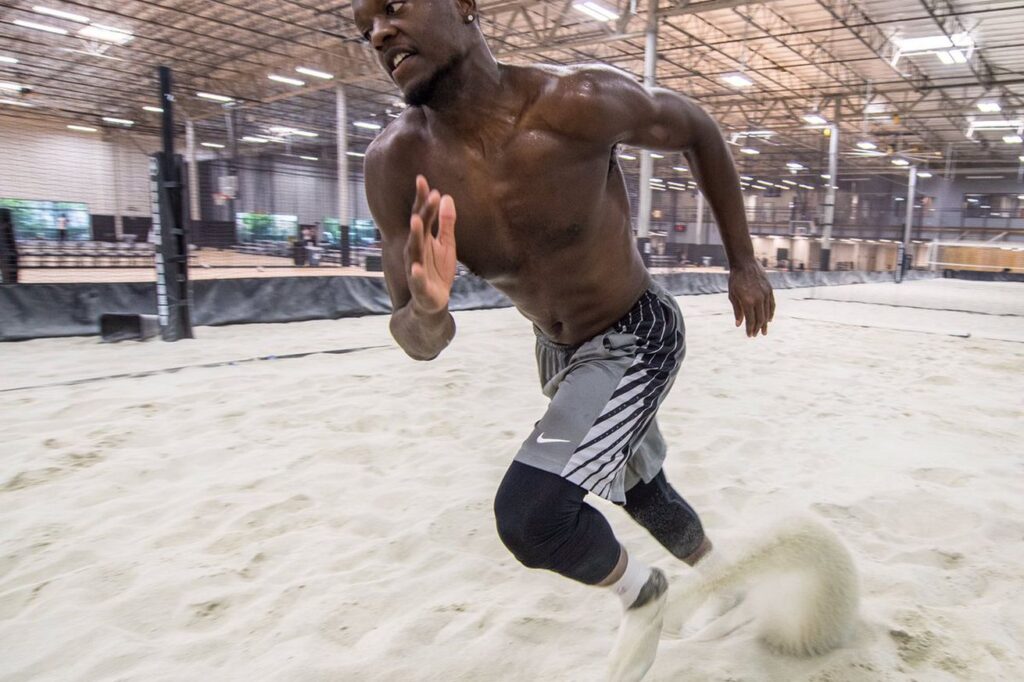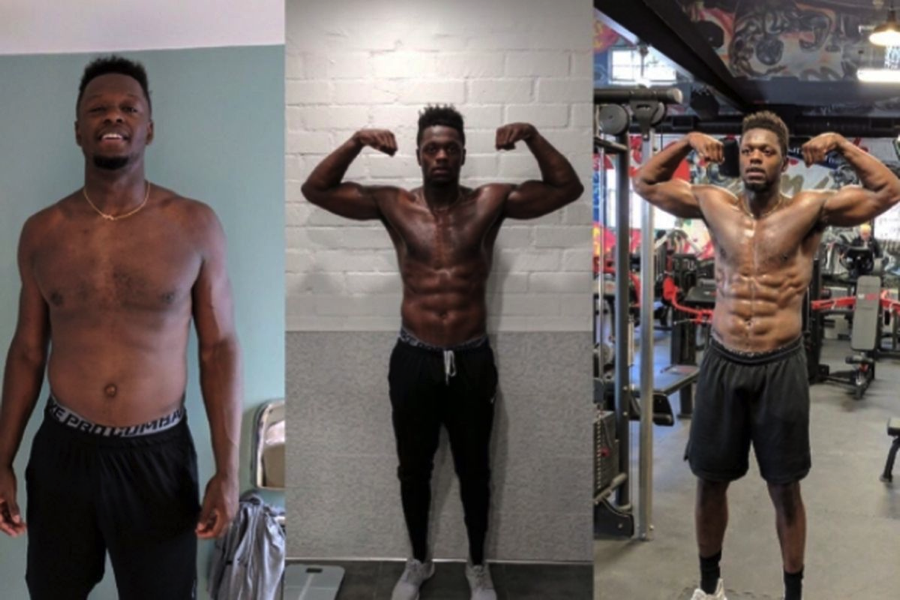Raise your hand if you’ve ever played a pick-up game with a teammate who looks to be in great shape – dude is cut with a different tank-top for each day of the week – but after driving the lane and running up and down the floor a few times, is huffing and puffing with his hands on his knees and has short-term amnesia on the defensive side of the floor.
raises hand
The moral of the story: aesthetic fitness is not the same as cardiorespiratory fitness.
That same moral applies when it comes to Julius Randle and his recent “body transformation”.
In recent months, we’ve seen clips of Julius playing in the Drew league and his trainer, Amoila Cesar – whose holistic and tailored approach I’m a huge fan of, if you haven’t listened to him yet on the LakersFilmRoom (LFR) podcast, I highly recommend it – has released workout snippets and before-after pictures on various social media platforms. If you haven’t see the pictures yet, here is Julius in all his glory:
There is a clear difference in his aesthetics – he could be a headliner on the Magic Body Fat % Hour. However, I have also read a lot of chatter about how these Drew league games and workout snippets correlate to Julius being in great game shape and having a monster year.
Here’s the reality: We don’t know that. Drew league games pale in comparison to the intensity and demands of an NBA game and the snippets and pictures don’t tell us enough about his training methods.
You can lose significant amounts of body fat and have increased muscular definition by maintaining a caloric deficit – without any increase in cardiorespiratory fitness.
So what is cardiorespiratory fitness?
Let’s start with a quick breakdown of the cardiorespiratory system – comprised of the heart, blood vessels, and lungs.
Here’s a picture:
There’s a lot there to chew on but here’s the basic rundown:
That thing in the middle is the heart, the tubes represent blood vessels, and the two gray shapes at the top are the lungs.
There are two circuits – the systemic circuit and the pulmonary circuit – that work in tandem with each other.
The systemic circuit begins when the heart pumps out oxygen rich and nutrient filled blood to the tissues and muscles. The blood is transported via the arteries – the red tubes. Oxygen (O2) is one of the main fuel sources for activity.
After delivering oxygen and nutrients, the blood picks up metabolic wastes such as carbon dioxide (CO2) and carries it back to the heart and other organs responsible for elimination. This blood is transported via the veins – the blue tubes. Once deoxygenated blood arrives back to the heart, the systemic circuit hands off to the pulmonary circuit.
The pulmonary circuit directs the deoxygenated blood from the heart to the lungs. At the lungs, blood releases the carbon dioxide it picked up – which we expel when breathing out – and is refilled with oxygen – which we inhale when breathing in.
This refilled oxygen rich blood is sent back to the heart and the systemic circuit takes over again. The cycle repeats continuously.
What changes would take place in Julius’ body with cardiorespiratory training?
Julius’s heart, blood vessels, and lungs would adapt and his cardiorespiratory system would become more efficient – resulting in increased stamina and sustained power on the court.
These beneficial adaptations are referred to as central, peripheral, and respiratory adaptations, respectively.
Central adaptations are those relating to the heart. Think of them as increasing the efficiency of your heart – it can pump more blood with less work required.
Peripheral adaptations are those relating to your blood vessels – arteries, veins, capillaries, etc – and muscle tissue. With adaptation, the vascular system becomes more efficient – it can deliver more blood and nutrients while carrying away more waste – and the quality of the muscle tissue increases – the muscles can do more work with less energy expenditure.
Respiratory adaptations are those relating to your lungs. The lungs get more efficient – they can intake more oxygen with less work. This means more fuel for the tissues and a decrease in respiration rate – less huffing and puffing.
Additionally, each of these adaptations decreases the amount of work required by the other – it’s a symbiotic relationship.
So what types of training improve cardiorespiratory fitness?
Training the cardiorespiratory system comes in two forms, differentiated by the reliance on oxygen: aerobic training and anaerobic training.
Aerobic training focuses on the aerobic system. This system uses oxygen for energy and is associated with lower intensity, longer duration activity. Think steady movement.
In order to train aerobically, Julius could do things such as longer distance running or cycling. This type of training is the main driver of peripheral and respiratory adaptations.
The rule of thumb for aerobic training is go at a pace where you aren’t out of breath and can still hold a conversation with a person next to you. Once you push past that threshold, you are transitioning into the world of anaerobic training.
Anaerobic training focuses on the anaerobic system. This system does not use oxygen for energy and is associated with high intensity, shorter duration activity. Think quick burst. These activities require energy at a higher rate than only oxygen can provide and thus have to rely on other fuel sources.
This type of training is the main driver of central – heart – adaptations.
Examples of anaerobic training include running sprints, 1 mile cycle sprints, 500 meter rowing sprints – anything that is high intensity. A well-known protocol for anaerobic training is high intensity interval training (HIIT).
Further, it’s very important to understand when aerobic activity turns into anaerobic activity – the point at which the demand for energy cannot be met by oxygen alone. Here’s a graph to illustrate:
The aerobic threshold is the last point at which only aerobic training is taking place – the energy demand is increasing – and the anaerobic threshold is the first point at which only anaerobic training is taking place – the energy demand is very high.
The green curve is the blood lactate curve. Lactate is a by-product of activity and as seen on the graph, increases considerably with anaerobic training. Lactate – indirectly – can have an unfavorable effect on muscle contraction and therefore athletic performance, if it’s not given enough time to clear out of the blood.
When Julius trains his aerobic system – resulting in higher levels of oxygen being delivered more efficiently – this bumps his aerobic threshold to the right. This means he can now engage in relatively higher intensity activities before his anaerobic system kicks in.
This is extremely important because the aerobic system is far more efficient than the anaerobic system and results in far fewer by-products. Julius can work harder and longer on the court while decreasing his in-game and between game recovery times.
What Are the True On-Court Indicators of Julius’ Fitness Level
When it comes to basketball, optimizing both aerobic and anaerobic training is crucial. Julius is in constant steady motion – taxing the aerobic system – interspersed with high intensity motions – taxing the anaerobic system.
Those players and teams who have an edge in their fitness levels have a significant edge during those moments where fatigue often plays a large factor – long spells of play without a stoppage, the end of quarters, the end of games, etc.
The example that instantly comes to mind for me is Lebron’s iconic sprint from half-court and block of Iggy’s layup in the closing moments of game 7 in the 2016 Finals.
These are crucial periods of play that can tip the odds and eventual outcome in or out of your favor. This rings even truer for the Lakers when you consider their style of play and thin margins for winning games.
The team defense relies, some might say too often, on constant switching of ball screens and the offense is predicated on ball and man movement with an increasing emphasis on pushing the pace and playing in transition. With the team’s low margin for error, a fitness advantage is imperative for increasing the chances of winning games.
The only way to tell if Julius is in prime cardiorespiratory and game shape is to see how his conditioning holds up during these moments and crucial periods of play – not pictures or short training videos.
These tells could include things like:
– Is he filling the wing and trailer slot in the 4th quarter and looking for that scoring pass from Lonzo? If you drafted that Ball and want that ball, you better have the endurance to run and the ability to recover quickly.
– Is he making multiple rotations and then fighting for a defensive rebound late in a quarter after he’s been on the floor for 8 straight minutes?
– Is he switching onto a primary ball-handler late in a game and able to move laterally to keep him from getting downhill into the paint?
– Are his hands on his knees and he’s struggling to inhale and exhale air after a spell of back and forth play?
– Is he playing the small ball 5 effectively for longer periods – constantly fighting larger players for position, getting into transition, and then being a primary screener – or is his energy level petering out after 90 seconds. The lineup of death, yeh but for which team?
– Is he attacking the lane with explosion to finish over bigger bodies late in the half and late in the 4th?
– Is he making sound decisions late in a game or is he reverting to bully ball, treating his right hand like a leper, and quiet as a Sunday country morning defensively? Fatigue (and stress) impacts decision-making and reverts players back to their comfort zones.
A prime example of this reversion is Russy and subsequently KD in the final 6 minutes of game 6 of the 2015-2016 WCF against the Warriors – both reverting back to iso ball.
These situations and plays are what Luke often refers to as “winning plays” and many of them require an elite level of aerobic and anaerobic fitness – particularly from a player like Randle who is called on to fill numerous roles offensively and defensively.
In sum: We don’t know whether Julius is actually in better game shape, that can only be proven during NBA games – in the meantime, he might get the Men’s Health cover.
If you want more information on Amoila Cesar’s training of Julius Randle, particularly in terms of his mindset and nutrition, then again I recommend listening to the LFR podcast.
Thanks for reading and please feel free to subscribe to the RSS or follow me on twitter or facebook. Until next time, 3CB out.



